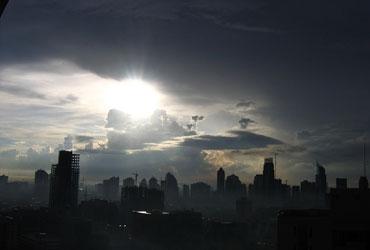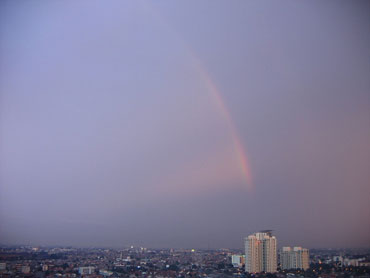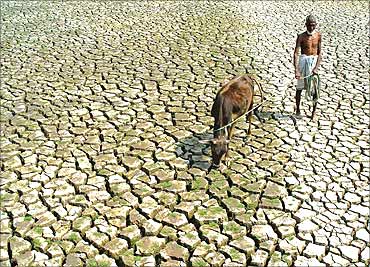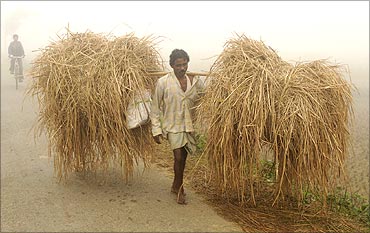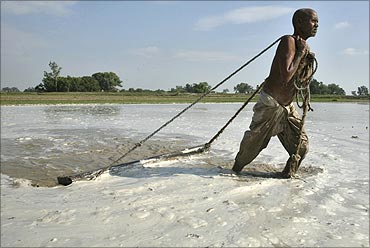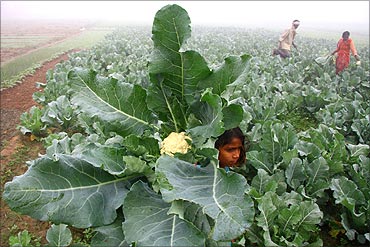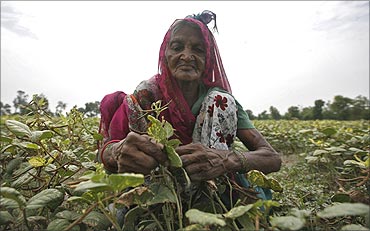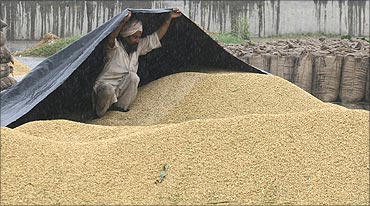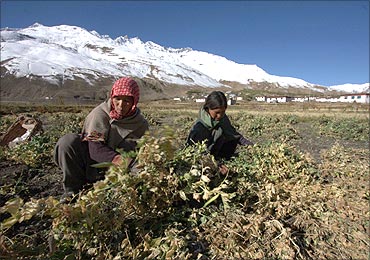 | « Back to article | Print this article |
Weather forecast: Why has the Met dept failed
While predicting the monsoons is a tricky job, the IMD has got it consistently wrong and impacted food prices.
The drought of 2009 still haunts the India Meteorological Department."It was worse than we initially thought," says IMD's director general Ajit Tyagi.
"As the months progressed, we could see that the monsoon will be less than our forecast."
In 2009, the IMD forecast that monsoons for the year would be normal.
Two months later, in June, it scaled-down its earlier forecast and said that the monsoons would be slightly lower than normal levels.
Click NEXT to read further. . .
Weather forecast: Why has the Met dept failed
By the end of 2009, both the predictions went horribly wrong as India witnessed its worst drought in 30 years.
The difference between actual rainfall and the forecast of the all-India Summer Monsoon Rainfall in 2009 was 22 per cent of the long period average, which is rainfall averaged over the entire country during the monsoon season from 1941-90.
A dismal record
The failure of the IMD to predict the monsoons correctly in 2009 was not a one-off incident.
Consider this: Since 1988, in the last 23 years, the IMD has been able to successfully predict the monsoon only nine times -- a success rate of just 40 per cent.
Click NEXT to read further. . .
Weather forecast: Why has the Met dept failed
Significantly, the IMD has never predicted a drought.
In fact, in the last decade, the country experienced droughts on three separate occasions, and the IMD's predictions in every one of these years pointed towards abundant or normal rain.
The impact of a faulty prediction can be significant.
On May 30, the monsoon rains or Idavapathy as it is called in Malayalam, hit the coast of Kerala three days ahead of schedule.
The early arrival boosted hopes of a good harvest and was in-line with the Met department's forecast of 'normal monsoon'.
In its second forecast, the IMD revised its forecast and announced that the rainfall in the country was likely to be 'below normal'. In its second forecast, the IMD revised its forecast and announced that the rainfall in the country was likely to be 'below normal'.
Click NEXT to read further. . .
Weather forecast: Why has the Met dept failed
The effects of the scale-down were immediate, with Soyabean and guar seed futures on the National Commodity and Derivative Exchange rising over concerns of low output.
A look at the Agri-Index of MCX shows that since the June 21st revised forecast, of a monsoon slowdown, the index has risen.
"The impact of monsoon on GDP is not that great as the share of agriculture in the GDP has fallen, but a bad monsoon has an inflationary impact.
"The wrong prediction of monsoon leads to volatility in the market and also increases hoarding," says DK Joshi, chief economist, Crisil.Click NEXT to read further. . .
Weather forecast: Why has the Met dept failed
The share of agriculture in the gross domestic product has fallen from 25 per cent in 1990-2000 to 15.7 per cent over the years.
Still, in 2000-09, 60 per cent of the population relied on agriculture, and therefore on the monsoons, for a living.
This also means that monsoon predictions play a huge role in what crops to sow and when."Getting the right prediction of the monsoon is very important. Many farmers sow crops depending on how the rainfall will be.
"There is a significant impact on the sowing pattern if the predictions go wrong" says food policy analyst Devinder Sharma.
Click NEXT to read further. . .
Weather forecast: Why has the Met dept failed
IMD's Tyagi, however, doesn't believe that this is an accurate way to judge the efficiency of his organisation.
"The practice of putting a number to the level of rainfall is unique to India. In 2009, after our initial prediction, we were able to see that the level of monsoon will be less than the forecast.
"However, it is very difficult to predict a drought. In severe cases, we can at best provide a trend," he says.
Tyagi could be right, but international weather departments have been able to forecast 'severe' conditions far more efficiently than the IMD.
One such example is the Burns' Day Storm that occurred over North-western Europe in January 1990, killing 47 people.
Click NEXT to read further. . .
Weather forecast: Why has the Met dept failed
Importantly, a four-day advance warning by the UK Met Department, which was repeated on television, was able to save many lives.
"The forecast by the IMD provides a very indicative figure and there is no reason to get carried away by it. We need to monitor the forecast very closely at regular intervals to know how the monsoon is performing. I take IMD's forecast with a pinch of salt," says Madan Sabnavis, chief economist, CARE Ratings.
A tricky job
Predicting the monsoons in India is a notoriously difficult task.
Since India falls in the tropical region, the changes in the weather conditions are more frequent than anywhere else in the world.
Click NEXT to read further. . .
Weather forecast: Why has the Met dept failed
With changing weather predictions, the parameters also frequently change, thereby having an effect on the forecast.
On the second-floor of Mausam Bhawan in New Delhi, where the IMD is headquartered, around six forecasters are trying to correlate data to keep a tab on how the monsoon is progressing.
Before 2009, the IMD would only issue two forecasts -- first in April and then in June. In 2009, the IMD started giving forecasts every month.
Click NEXT to read further. . .
Weather forecast: Why has the Met dept failed
The IMD determines the forecasts by inputting the present atmospheric conditions such as wind speed, atmospheric pressure, humidity, etc into an empirically-determined statistical model and compares the output with the historical ISMR data to forecast the pattern of the monsoons.
Experts say the problem with the present method is that if any of the parameters change drastically, then the whole prediction goes wrong.
In 2009, El Nino was one such parameter.
"The IMD uses both the dynamic and statistical model to forecast monsoons.
"However, because of the climatic changes there are continuous changes in these parameters and so also in the forecast of monsoon," says K Ashok, scientist, Indian Institute of Tropical Meteorology.
Click NEXT to read further. . .
Weather forecast: Why has the Met dept failed
The dynamic model is relatively new to India and the IMD says it is only efficient in predicting short-range (two-three days) and medium-range (10-15 days) weather conditions.
The IMD has been making the forecasts for monsoons for more than 125 years.
In 1886, the first forecast was made based on a study of the thickness of the Himalayan snow and the monsoon rains, following a famine in 1871, after which the practice of predicting monsoons for better preparedness was established.
Since the model was unpredictable, the first change was introduced by British physicist and statistician Sir Gilbert Walker in 1909, who introduced the statistical model.
Click NEXT to read further. . .
Weather forecast: Why has the Met dept failed
Later, he found India too vast and divided it into two homogeneous regions: North-west India and Peninsula and separate forecasts were made.
The architect of the modern monsoon prediction in India was a man who had nothing to do with monsoons for a large part of his life. In 1987, when the IMD failed to predict the drought, the government asked Vasant Gowariker, who was then the secretary in the department of science and technology and a former director of Indian Space Research Organisation to understand and correct the prediction of monsoons in India.
Gowariker found that the method of monsoon prediction being followed by the IMD was outdated.
Click NEXT to read further. . .
Weather forecast: Why has the Met dept failed
On his insistence, the IMD introduced a model which determined forecast after studying 16 parameters from around the world.
Also, under Gowariker, the IMD went back to issuing a common forecast for the country. Although the model was not perfect, it was spared criticism as there were no droughts between 1988 and 2001.
After the drought of 2002, which the IMD failed to predict, the Gowariker model was changed.
Instead of Gowariker's 16-parameters which were found to be too broad, only 5-8 parameters were retained but only to be changed again after the failed prediction in 2007.
At present, the IMD has stopped considering just parameters as the basis of forecasting. Instead, various models are designed taking a combination of parameters.
Click NEXT to read further. . .
Weather forecast: Why has the Met dept failed
Interestingly, the IMD preferred to introduce no changes after the drought of 2009.
"There is no doubt that there is a lot of scope for improvement in the forecast of the IMD. But, predicting the monsoon in India is very difficult because of the various factors involved.
It will take IMD at least 5-10 years to be able to correctly predict it," says M Rajeevan, scientist, National Atmospheric Research Laboratory.
Gearing Up
Officials at the IMD agree that the organisation does not possess the best technology the world has to offer.
Another area of concern is the over-dependence of IMD on foreign technology.
"The systems that we have are designed in France.
"They have shared their technology, but not the best. The US has refused to give their technology," says an official on the condition of anonymity.
Click NEXT to read further. . .
Weather forecast: Why has the Met dept failed
Last year, objections were raised by the Indian Air Force over the use of Chinese Doppler radars in Mumbai and more recently in Goa.
In 2010, the government launched a 'Monsoon Mission' to carry out focused research across organisations and develop indigenous prediction models.
However, a year later, no substantial achievements have been shared.
In the Union Budget for 2011-12, the government increased the modernisation Budget of IMD by 13 per cent to Rs 130.80 crore (Rs 1.3 billion).
A major portion of this will be spend to buy 13 2DWR Doppler radars, two of which have been placed at Hyderabad and Mumbai.
Compare this to the US, where the National Weather Service collects the data through a network of 158 highly advanced high-resolution Doppler radars called NEXRAR (Next-generation Radar).
For a country that lives and dies on not just the monsoons but also intimations of it, the IMD needs to equip itself with the latest technology and equipment, ramp up its methodological know-how and attract the right kind of manpower talent if it has any hopes of staying relevant today.

